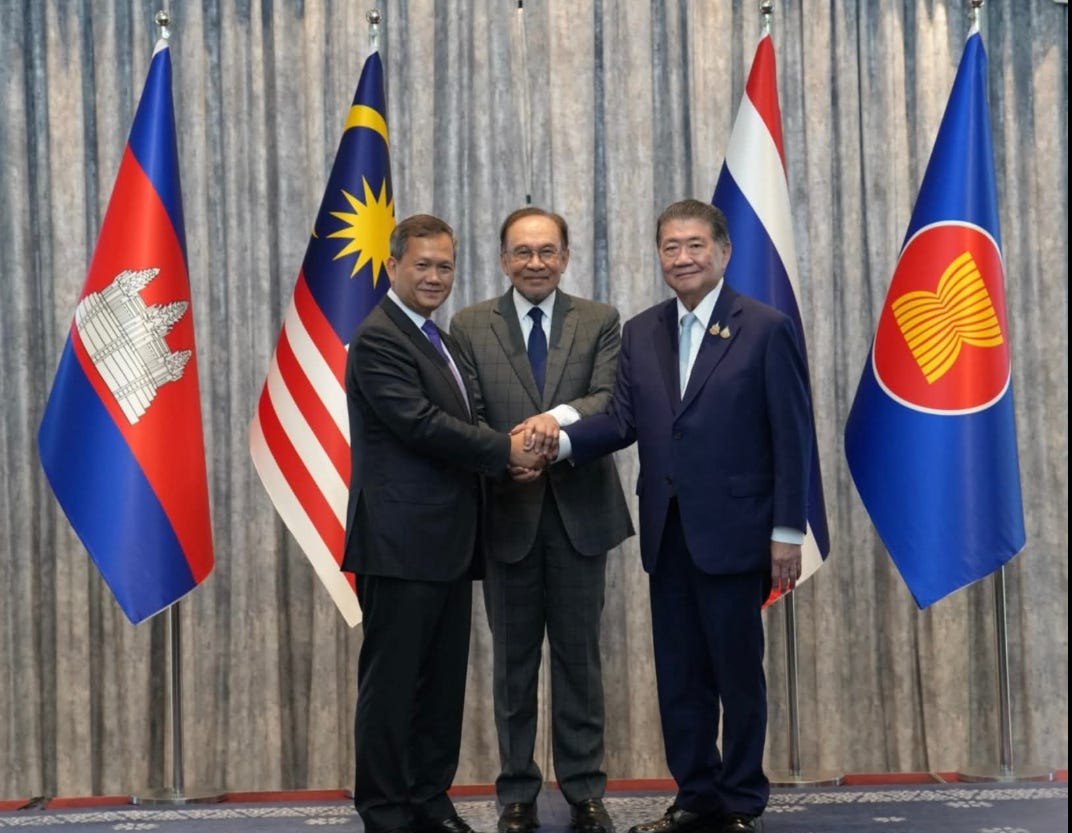
Murray Hunter
Thailand and Cambodia agree to an immediate ceasefire in border fighting
Murray Hunter
Jul 29, 2025

This afternoon in Kuala Lumpur, The Cambodian prime minister Hun Manet and acting Thai prime minister Phumtham Wechayachi agreed to a ceasefire according to the following conditions;
1. Emergency ceasefire without conditions that will be in effect at 2400 on 28 July 2025.
2. Organize an informal meeting of the commander of the Rural Military Commanders (Thai, Rural Military 1 and 2 and Cambodia, Military Village 4 and 5) at 0700 on July 29, 2025 and continue to organize a meeting with the military and military brigades led by the ASEAN chief if there is agreement from both parties and
3. Cambodia-Thailand General Border Committee (GBC) meeting on 4 August 2025, which
Cambodia will host.
The meeting was hosted by Malaysian prime minister Anwar Ibrahim flanked on each side by officials of the Embassy of the United States and China. The host, Malaysian prime minister Anwar was able to convene the meeting after Thailand had initially refused to join any direct meeting with any Cambodian delegation, only after US president Donald Trump gave an ultimatum that trade negotiations on tariffs would be postponed, if Cambodia and Thailand didn’t reach a ceasefire agreement.
With the dead line for tariff negotiations with the United States being August 1, no other real outcome could have occurred in the Kuala Lumpur meeting. The agreement reached returns negotiations back to bilateral meetings.
Last hours before cease fire
During the last hours before the ceasefire was to take effect, both sides were very active in the battle theatres along the border.
According to Khaosod, the Thai 2nd Army Region detected an number of PHL-3 missile batteries being moved into Udon Maechai Province. The Cambodians fired a number of salvos at strategic targets iChong Daeng-Preah Vihear, and Phu Makheau. The Cambodians have also moved long range missiles around Samrong Airport area. Cambodian army was also observed laying mines around disputed border areas.
The Royal Thai Air Force used F-16s to re-bomb the Ta Muen Thom and Ta Kwai Temple areas. There has been intense fighting along border areas where Cambodian forces are trying to consolidate land they are occupying before the mid night deadline.
The Thai Air Force targeted a scam centre at the Chong Sai Taku border crossing, which is owned and operated by a Cambodian scamming tycoon, Ly Yong Phat, who was recently sanctioned by the US Government. The building was similar to the other scam centre bombed at Chong Sangam as few days earlier. The Thais claimed these were also military command centres.
Ly Yong Phat is a senator for Koh Kong Province and a close advisor of Hun Sen. The targeting of scam centres inside the Cambodian and the ongoing feud between Hun Sen and the Shinawatra family hint at some of the underlying reasons for the fighting.
The Thai armed forces had over the last four days focused on targeting scam centres and attacked the operations owned by Kok An, another close associate of Hun Sen. Electricity and communications cables to a casino and money laundering centre in Poi Pet going underground to the Thai side were also cut during the conflict.
The above issues were not touched upon during the talks in Kuala Lumpur.
There are over 140,000 people displaced through evacuation in Ubon Rattathani, Sisaket, and Suring provinces. Due to the sparse population and small number of villages on the Cambodian side, much less were displaced.
Can the cease fire hold?
The agreement in Kuala Lumpur is very much an interim ceasefire.
The acting Thai prime minister must now brief the leader of the 2nd Army Lt General Boonsin Padklang, who very much is his own man and will operationally call the shots on the ground. The Cambodian prime minister must brief his father Hun Sen, who is personally running the military side.
The Thai public may not accept the cease fire very well, if Cambodia is seen to ‘get off the hook’ for the damage done. The civilian government may be heavily criticized for this. Seeing Phumtham Wechayachi shaking hands with Hum Manet could be enough to bring down the Pheu Thai party.
Thus, any final decisions about how strong the cease fire will depend upon those two leaders, not the two prime ministers. The battle theatres have been left in a situation, where it will be very easy for any side to “create’ a mishap that could easily lead to fighting once again.
This is why it was very important to have Chinese Government representation at the meeting in Kuala Lumpur on Monday. The Chinese will be more influential than either the US or Malaysia in the next few days.
If both Thailand and Cambodia follow the protocol developed in Kuala Lumpur, this would be a much-needed win for ASEAN, which prime minister Anwar Ibrahim could take some credit. However, the underlying causes of the clashes are not truly political or historical, as many pundits have been saying.
The Cambodian economy is hurting very badly, especially after the scamming operations have been seriously checked. Thailand is interested in securing some geographical high ground, in order to be able to fight off any surprise attack more easily.
Physically, it will be very difficult for observers to patrol this 400 km part of the border. Its not justice the border that must be monitored, but overflying rockets into civilian areas as well. There will be many issues in territory demarcation.
The fundamental underlying boundary , territorial issues have not been resolved.
ReplyDeleteThey just kicking the can down the road.
Anyway a ceasefire , stopping further loss of life and destruction is Good.
Prelude to just how ugly the South China Sea territorial seas dispute may get in future.
'Prelude to just how ugly the South China Sea territorial seas dispute may get in future.'
ReplyDeleteMfering fear mongering of know-nothingness!